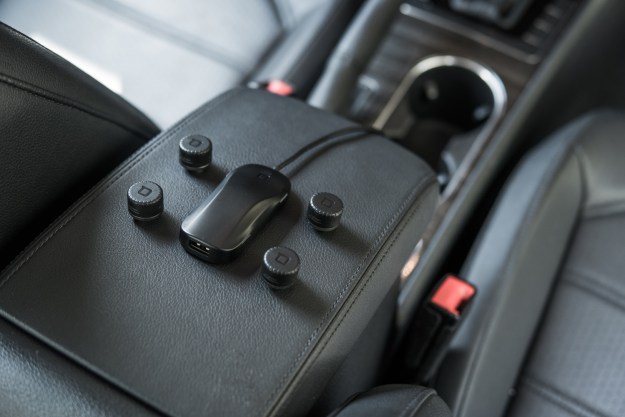
“The ZUS Smart Tire Safety Monitor makes it easy to keep tabs on your tires with your phone.”
- Premium look and feel
- Incorporates USB charger
- AccurateTemp algorithm helps avoid false alerts
- Doesn’t include 12-volt car plug
You may already know the Nonda company from its ZUS Smart Charger and the Nonda iHere, two innovative gadgets that locate both your car and your keys, respectively. Its latest in-car tool, the ZUS Smart Tire Safety Monitor, promises to keep tabs on your tires and make sure you’re never stranded with a flat. We put an early sample through its paces for our ZUS Smart Tire Safety Monitor review, to see if the cost and hassle of the ZUS system are worth it.
Initial setup
The ZUS Smart Tire Safety Monitor was launched through a popular Indiegogo campaign that raised over $300,000, well above its initial $20k goal. The cost for early backers was only $99 — a slight discount from the retail price of $120. The ZUS kit includes four tire sensors, four anti-theft nuts, a small metal wrench for installation, and a sleek car-shaped USB charger that acts as a hub inside your vehicle.
The concept of aftermarket tire pressure sensors that communicate to your phone via Bluetooth has been around for several years. But many devices have issues with theft, and can be rather large and awkward looking. Thankfully, the new ZUS Smart Tire Safety Monitor sensors look and feel premium and secure to your vehicle to avoid theft in only minutes. Each sensor is labeled clearly with the tire it should be attached to — “Front Left,” “Rear Right,” and so on.

The first step to installation is to plug the charger into a USB port – you’ll need to own a modern car that has one, or own a USB car charger that plugs into a cigarette lighter. We’re disappointed that Nonda didn’t include a universal 12-volt lighter plug, since many users will be driving older vehicles that are void of USB ports. Once plugged in, you simply pair the dongle with your phone via Bluetooth and the ZUS application. You can then screw the sensors to each wheel and ensure the ZUS application displays the current tire pressure and temperature. A couple of our tires required driving a few miles for the information to begin displaying on the application. To avoid theft, each sensor can be locked in place with the included wrench to secure the anti-theft nuts, and will not simply twist off like a normal valve cap.
Real-time data
While most buyers will likely have older cars without any tire pressure information, it can also be useful for those with newer vehicles. The 2012 Lincoln MKZ Hybrid we tested with has a standard tire pressure monitoring system (TPMS) warning light, but no additional information on air pressure or temperature. I recently walked out to a flat, and the warning light switched on only when it was too late to drive on the tire. With the ZUS Smart Tire Safety Monitor, you can get early warnings for slow leaks. The company’s proprietary AccurateTemp algorithm will normalize temperature fluctuations throughout the day, so you can see accurate tire pressure changes.
By tracking the changes in pressure, relative to changes in temperature, the system should be able to understand when an actual problem occurs.
Using the real-time information in the ZUS application, you can monitor the current tire pressure and temperatures. The application gives a notification on your phone if something is wrong and the car-shaped USB charger unit will flash a green light on the tire that has a problem. Thankfully, we had no major punctures or issues, but were able to monitor and see the historical fluctuations in our tires.
In general, for every 10-degree Fahrenheit change in air temperature, your tire’s inflation pressure will change by about 1 psi (up for hot, down for cold). You can use the ZUS application to monitor each tire in different weather and driving conditions to see how the pressure is affected. The application lets you put in your vehicle’s recommended tire pressure and then shows the variation in pressures over time. We were able to see that the rear tires generally ran low in colder temps and added a bit more air to help with fuel economy.
Is it worth it?
By tracking changes in pressure, relative to changes in temperature, the ZUS Smart Tire Safety Monitor should be able to understand when your tires need attention, whether from a slow leak or an impending flat. Nonda also claims a future version of the app will enable cloud-enabled family sharing, so you can monitor all of your family vehicles and ensure they are ready to hit the road without problems.
At $120, it may be worth buying for owners of older vehicles who want the sense of security you get with a TPMS. Owners of newer vehicles with a TPMS may also appreciate the enhanced detail and accuracy of the ZUS, over the standard warning light.


